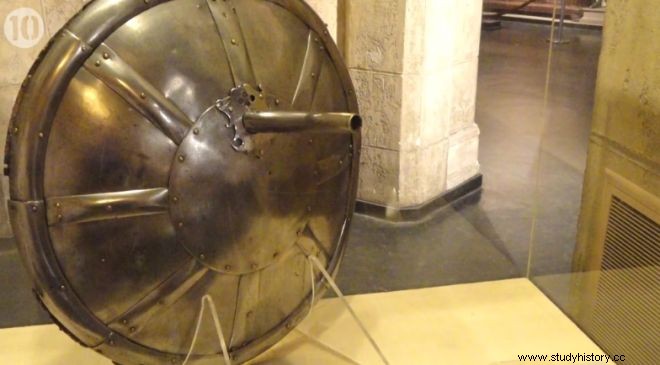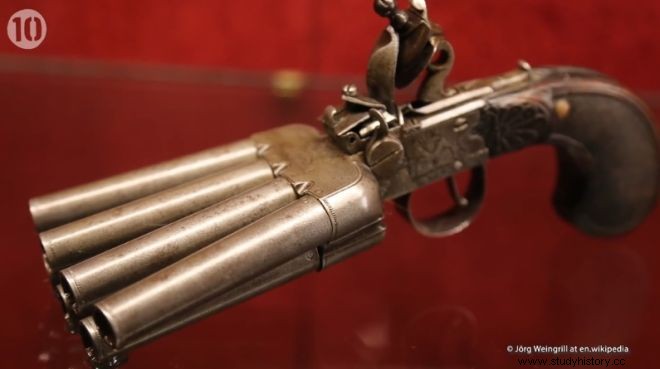From the "crooked barrel" of the Germans, to the revolver with a folding knife and from the vespa-cannon to Archimedes' superweapon. These are ten guns that may not have gone into mass production, but each went down in history for a different reason.
Most nightmarish of all, the trick the Mongols used in retaliation for their defeat spread death across Europe.
The 10 weapons gathered in the following video:
First we see the Krummlauf barrel. It was another one of the futuristic constructions of the Hitlerites. The idea was to develop a barrel that would shoot from an angle of up to 90 degrees, however production was deemed too expensive and not widely produced. The Krummlauf "clipped" on the Sturmgewehr 44 while carrying a periscope that allowed the user to shoot around corners without being exposed to enemy fire.
Below, the MythBusters find out that the weapon was deadly:
Various versions were proposed, one for infantry and one for tanks, as well as 30°, 45°, 60° and 90° angle versions, one for the StG 44 and one for the MG 42 machine gun. The "Krummlauf" had short life – 300 shots for the 30° version and 160 shots for the 45° one. The 30° version achieved a concentration of shots in an area of 35x35 cm at 100m, as the accessory caused a significant decrease in their accuracy.
Then the Apache carousel is introduced . It became known in the early 1880s, from the French underworld under the name Les Apaches. The weapon also incorporates a folding knife and an iron fist.
The firing range was limited but it could be folded up and easily hidden in a pocket. However, there was a problem with its safety and several times it could explode in its owner's pocket.
Next is the medieval "shield-cannon" . The maker was Giovanni Battista of Ravenna and he proposed it to King Henry VIII of England, who ordered 100 such pieces. The British equipped their ships with similar, larger shields that they built over the next few years themselves, after 1544 when the weapon was first introduced.
However the idea did not go far as the individual shield was unwieldy for the warrior.

For the sequel, Kpinga :The Azande tribe of Africa made this paradoxical knife. The weapon had multiple blades and the fins were aligned so that the "victim" would be hit however it hit him. Today one can only see it in museums. Also answered as Hunga Munga. It also symbolized power and prestige and was usually held by the leading members of the tribe and their families.
The rare duck's foot pistol: He could fire four cannons at once. It was built at the beginning of the 19th century and today it is considered a collector's item, with its value reaching 3,000 pounds.
It also came in many different versions with a hexagonal barrel, but also with three barrels. This too was not widely produced, as its accuracy was understandably questionable.

"Archimedes' grab"
Here we have the weapon of war invented by Archimedes to deal with the Roman fleet besieging Syracuse.
There are no archaeological findings or depictions of the structure. It is mentioned by ancient historians describing it as a kind of "crane with a hook". It seems to have been an application of Archimedes' studies around levers and pulleys.
A scientific team attempted in 1999 an experiment in making a grabber. Within 7 days they designed, built and successfully operated a grapple that successfully sank a trireme in the harbor in front of the ancient walls of Syracuse.
More specifically, the grab was used in the Second Carthaginian War in 214 BC. at the siege of Syracuse. The Roman fleet had more than 120 five-ships under the admiral of Marcus Claudius Marcellus. The Romans attacked by night, but were surprised by the Syracusans and the unprecedented rapture, and combined with catapult-throwing cotrons. Losses were heavy, ships were sunk and panic ensued, according to Polybius and Titus Livius.
"Vespa 150 TAP"
Or else, the vespa cannon.
In the 1950s France had to deal with revolts in the colonies in Algeria and Indochina. Then, the country's military realized they needed a fast-moving artillery vehicle.
So they made the military Vespa, or more simply a scooter that carried its own piercing weapon.
The Vespa 150 TAP was specifically designed for the French airborne special forces, the Troupes Aéro Portées corps.
The goal was to drop from the air directly onto the battlefield.
Attached to the scooter was an M20 gun, which proved capable of destroying makeshift rebel strongholds. The M20 was designed as an anti-tank weapon and under ideal conditions could penetrate 100 km at a distance of 6,400 meters.
Of course, it is worth noting that the weapon could not be used while the Vespa was in motion, but was used to easily transport the M20.
"The Great Panjandrum"
The Panjandrum wheel was a weapon consisting of two large wooden wheels with a ton of explosives crammed together inside the shaft.
It weighed about 1800 kg and was tested by the British in World War II.
After extensive testing, the prototype was destroyed in the final test where it ran dangerously off course and disintegrated into the sea.
"Nest of bees"
The "hive" of the Chinese shot poisoned arrows at the enemy.
Mythbusters looks below at the Hwacha, an evolution of the Chinese holo developed in the 15th century that could fire 100 or 200 arrows at once.
"The Black Death"
In 1347 the plague ravaged the Far East and reached the eastern ends of Europe. The Mongols at that time were besieging Kafa, in the Crimea. Decimated by the plague, they dealt a sneaky deathblow to their opponents.
Using giant catapults, they threw the bodies of the plague victims over the city walls.
Within a few months, death was ravaging all of Europe. The disease spread rapidly to North Africa, Italy, Spain, England, France, Austria, Hungary, Switzerland, Germany, Scandinavia and the Baltic countries.
In little more than two years, more than a quarter of the population of Europe, about 25 million souls, fell victim to the disease.
